Phyl of the Artisan Bread Bakers Facebook Group chose this Fig and Almond Bread as the BOM (bread of the month) for September. This bread is a sneak preview from the upcoming book of breads by Nick Malgieri. The book is scheduled to be released in Fall of 2012. If this bread is any indication of the types of breads that will be included in the book, then I’ll have to add it to my list.
Nick got the inspiration for his bread from the Royal Crown Bakery in Brooklyn, New York’s fig and walnut batard-shaped loaf. Although I’ve never been particularly fond of figs, my taste tester likes figs so I thought it would be good to try something new. I’m trying to step out of my baking box. 🙂
Fig and Almond Bread
Makes
: Two small round loaves, each about 8 inches in diameter
Recipe from: http://www.nickmalgieri.com/blog/2011/07/sneak-preview-fig-and-almond-bread.html
Ingredients:
- 1 cup/about 6-7 ounces/230 grams dried Calimyrna figs
- 1 cup/5.5 ounces/150 grams whole unblanched almonds, coarsely chopped and lightly toasted
- 1 3/4 cup/375 grams room temperature tap water, about 75°F
- 2 1/4 teaspoons/7 grams fine granulated active dry or instant yeast
- 3 cups/400 grams bread flour (spoon flour into dry-measure cup and level off)
- 1 cup/135 grams whole wheat flour
- 1 tablespoon/15 grams sugar
- 2 teaspoons/14 grams salt
- Olive or vegetable oil for the bowl
- 1 tablespoon unsalted butter, melted, for brushing the loaves after baking
A heavy 12 x 18-inch jellyroll pan (or baking pan) dusted with cornmeal, plus a spray bottle filled with warm water
Directions:
Snip the stems from the figs
; if they’re at all hard or dried out put them in a bowl and cover them with boiling water. Let them steep for 15 minutes, the drain and pat dry with paper towels before cutting into 1/2-inch dice.
Pour the water into the bowl of an electric mixer and whisk in the yeast. Wait 30 seconds and whisk again.
Mix the flour, whole wheat flour, sugar, and salt together and use a large rubber spatula to stir them into the liquid a little at a time until you’ve used all the flour. Make sure all the flour is mixed into the liquid and there isn’t any clinging to the side of the bowl.
Place the bowl on the mixer and attach the dough hook. Mix on lowest speed until the dough comes together around the dough hook, a minute or two. Stop the mixer and pull the dough away from the hook; let the dough rest for 15 minutes.
Increase the mixer speed to low/medium and mix until the dough is smoother and more elastic, about 2 to 3 minutes longer. Add the figs and almonds and mix another minute to distribute them as well as possible throughout the dough. They’ll be more evenly mixed after the turns are given to the dough.
Scrape the dough into an oiled bowl and turn it over so that the top is oiled. Cover the bowl with plastic wrap and let the dough ferment until it starts to puff, about 30 minutes.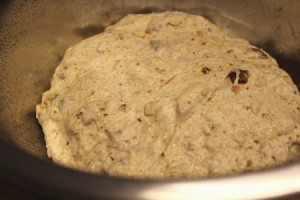
Scrape the dough to a floured work surface, flour your hands, and give the dough 2 turns as described below:
Nick Malgieri’s Method for Turning the Dough: Generously flour the work surface; scrape the dough onto it. Flour your hands and gently flatten the dough to a disk. Fold the two sides in to meet at the middle, then roll the top toward you all the way to the end. Invert (seam side up), flatten and repeat.
Or
Tartine Method for Turning the Dough: I didn’t use Nick’s method for turning the dough. It was a little confusing to me. I used the Tartine method instead. You don’t even need to take the dough out of the bowl in the Tartine process. View the Tartine process for turning the dough – includes photos.
Repeat the folding process using either one of the methods above for turning the dough.
Let the dough ferment until it has fully doubled in bulk, about 30 minutes longer.
To shape the dough into loaves, use a flexible plastic scraper to slide it from the bowl, right side up, to a floured work surface; try to keep from deflating the dough.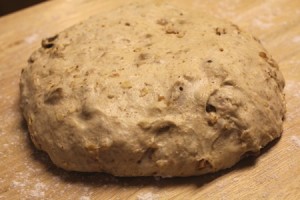
Divide the dough into 2 equal pieces. Round each loaf by pushing against the bottom of the dough all around with the sides of your hands held palms upward. The dough will quickly form an even sphere.
Place the loaves well apart on the prepared pan (or greased parchment paper) and cover them with a flat-weave towel or piece of sprayed or oiled plastic wrap. Let the loaves rest until they start to puff again, about 30 minutes.
As soon as you cover the loaves, set a rack in the middle level of the oven and preheat to 450 degrees.
Once the loaves are proofed to about 50% larger than their original size, flour the palms of your hands and gently press to flatten them to about 1-inch/2.5-cm thick.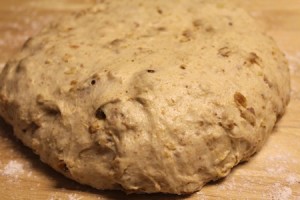
Use a serrated knife or lame to cut a deep slash across the diameter of the loaf, and another at a 90-degree angle to it, or cut 4 overlapping slashes to form a square. Generously spray the loaves with water. Place the pan in the oven.
Wait 2 minutes, then open the oven and spray the loaf again.
Repeat step 15. Wait 2 minutes, then reduce the oven temperature to 400 degrees.
Bake the loaves until they’re well risen, deep golden, and the internal temperature reads 200°F. on an instant read thermometer, about 30 minutes.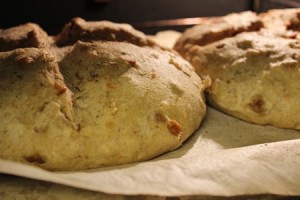
Place the baked loaves on a rack and brush them all over with the melted butter; cool completely.
Serve the same day or wrap loosely and keep at room temperature for a day or so. Wrap and freeze for longer storage.Every bread provides a unique experience and this one is no different. I’m glad I tried it. I like the combination of figs and almonds. I guess I like figs after all!
This bread has been YeastSpotted. Please visit Wild Yeast to view all of the lovely breads in the roundup.
Happy Baking!
Cathy
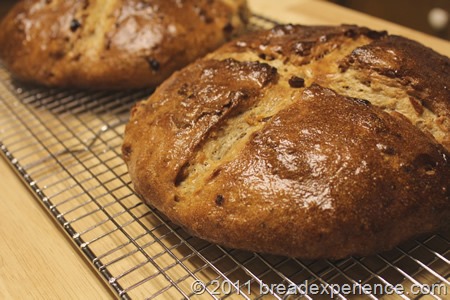
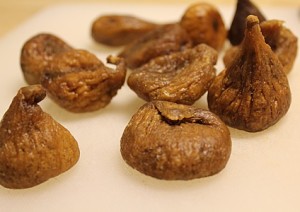
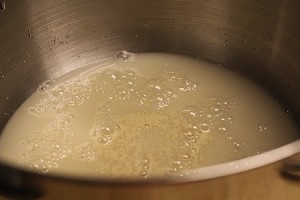
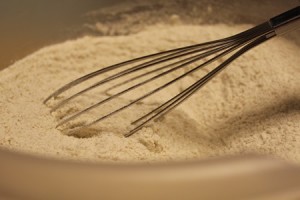
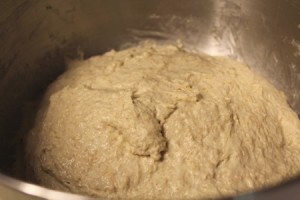
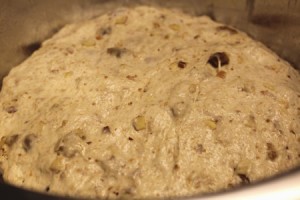
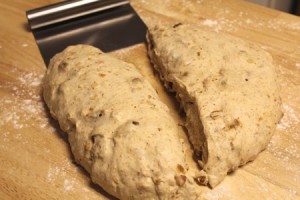
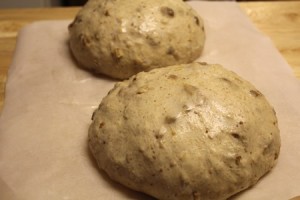
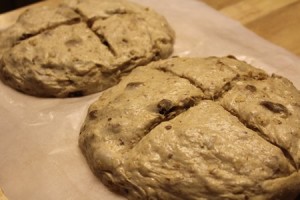
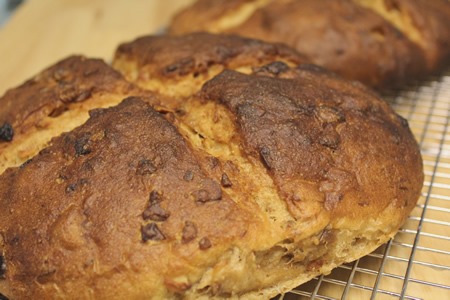
gaaarp says
Beautiful bread! And I love your process photos. I’m glad you liked it!
Elwood says
You always make the prettiest breads and these are no different. I like figs, so I’m going to have to try this one.
Cathy (breadexperience) says
Thanks Elwood! This is definitely one to try. Let me know how you like it.
Judy's Bakery & Test Kitchen says
This looks just wonderful! I love figs. This might be good for my upcoming holiday. I’d like to bring something different for our hostess.
Anonymous says
I didn’t quite get the Dough Turning. This is that part that’s got me confused: “roll the top toward you all the way to the end”. Can anybody explain this a little mire clearly? It sounds almost like shaping a batard or baguette, but then it would seem difficult to get a round shape again…..
Cathy (breadexperience) says
To be honest, I couldn’t quite visualize Nick’s turning the dough method either so I didn’t use it. I used the method in the Tartine Country Bread post. You can view that method here http://breadmakingblog.breadexperience.com/2011/02/tartine-country-bread.html#turningdough
Goreti says
Love this bread. It is wonderful. I ate almost an entire loaf by myself. Love figs. I am making it again today but decided to make it with craisins w/orange zest. Also used some of the orange juice in place of all water. I’ll probably be making it over & over again using different combinations. Thanks for sharing.
Cathy says
Hi Goreti, I’m so glad you liked this bread. It’s a keeper for sure. Your combinations sound wonderful! Thanks for sharing your ideas!